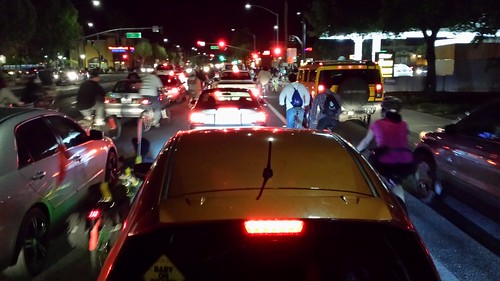“Safety Culture” is the concept that acting safely is considered the norm in the workplace environment. Researchers have been working for about the past decade to transfer lessons from workplace safety culture to a “traffic safety culture” to improve road safety.
At a workplace with safety culture, shenanigans and attitudes that can get people maimed and killed are not tolerated, while safe behavior is encouraged and rewarded by everybody. In a workplace with safety culture, safe behavior is the norm, and people who engage in unsafe behavior are ostracized.
Last Friday, the Safe Transportation Research and Education Center (SafeTREC) at UC Berkeley hosted a seminar and panel discussion on ways to improve traffic safety culture in California. The presenter Bayliss Camp (PhD in Sociology) supervises the Driver Competency and Safety Projects Unit at the California DMV. He serves also as a member of the California Strategic Highway Safety Plan (SHSP), the SHSP Traffic Safety Culture Task Force, the Transportation Research Board (TRB) Committee on Safe Mobility of Older Persons (ANB60), and the TRB Roadway Safety Cultures Subcommittee.

SafeTREC says they’ll have slides and audio from the presentation later this week, but some nuggets from SafeTREC to think about in the meantime:
- Camp says culture is dynamic and changeable. Consider, for example, American attitudes about drunk driving, which have changed dramatically over the past half century. 50 years ago, it was considered acceptable to drive drunk. Today, drunk driving is mostly considered socially unacceptable. MADD changed the stories and symbols to change enforcement and beliefs so that if you have a DUI, you’re a bad person. Changes in attitudes regarding seat belts and child seats have also occurred. Advocates are now working to make the use of mobile devices while driving similarly unacceptable.
- Law enforcement plays a role, though their role is not exclusive. In the past, police and judges gave drunk drivers a pass if nobody was injured. Today, we have checkpoints and sentencing.
- Historically, traffic safety measures have focused on individual behaviors, but that has translated into “it’s the other guy’s fault” and legal defenses involving the soporofic effects of the new car smell. Nobody realizes “that idiot driver” often applies to themselves. In a traffic safety culture, everybody realizes their potential culpability and accept responsibility for their actions.
- Speeding: 40% of California drivers admit to believing that driving more than 15 MPH over the speed limit is normal and not immoral. The road in front of my home has a 35 MPH speed limit, which is about right. The 85% percentile speed is 50 MPH, which is insanely sociopathic. (See how I did that? I labeled scofflaw speeders to mark you as evil in the hope that I can change traffic safety culture.)
- Bicycles: The attitude that bikes should stay to the far right is a cultural thing. I’ve written before how this discriminatory cultural attitude against bikes on the road is a result of intense lobbying and marketing by automotive groups such that today many people hold the mistaken belief that bikes are “dangerous.” (See, I did it again: I called you “mistaken” if you believe bikes should stay out of the way of other traffic.)
There’s a whole host of law-breaking behavior that’s considered “normal” when driving, and traffic enforcement is often considered to be nothing more than a form of revenue generation rather than an expression of public policy and safety. We have a long ways to go before we have any kind of traffic safety culture in the United States. Several groups actively fight these efforts to create a traffic safety culture (can you believe that?), but I’m glad to see people working on these issues.
A big part of the problem is the Lake Woebegon effect, in which almost everyone believes they’re an above average driver.